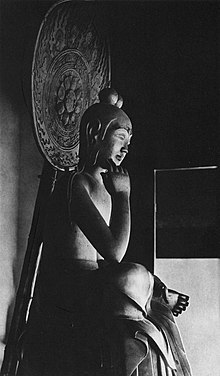Chūgū-ji
The Chūgū-ji ( Japanese. 中 宮 寺 ) is a Buddhist temple in the city of Ikaruga ( Ikoma district ) in the Japanese prefecture of Nara , in the immediate eastern vicinity of the Hōryū-ji , under whose administration it was for a long time.
history
The traditional founding date of the Chūgū-ji is the year 621, in which Anahobe-no-Hashihito ( 穴 穂 部 間 人 ), the wife of Yōmei -tennō, died and her son, Shōtoku -Taishi, made her residence in the province of Yamato a temple should have rededicated. Due to its geographical and administrative proximity to the Hōryū-ji, the Chūgū-ji always belonged to the same Buddhist group to which the Hōryū-ji belonged, i.e. first Sanron-shū , then Hossō-shū , from the Kamakura period Shingon-shū and finally since 1951 Shōtoku-shū .
However, there are almost no sources on its history until the renovation of the temple by the Risshū monk Eison ( 叡 尊 ; 1201–1290) and the nun Shinnyo ( 信 如 ; 1211–?) In the 13th century. However, it is believed that the temple was an active monastery for Buddhist nuns for most of its history. Over time, the emperor's ring consort Hashihito was stylized as the temple's patron saint. The most famous example of this is the mandala Shōkō mandarazu ( 聖皇 曼荼羅 図 ) made on Hōryū-ji in 1254 , in which she is represented as Buddha Amida according to the theory of Kami as manifest Buddhas .
Cultural assets
One of the most famous cultural artefacts at Chūgū-ji is a statue from the later Asuka period , which acts as the temple's honzon , depicting the seated Bodhisattva Miroku and made of wood from the camphor tree and the hinoki cypress .
Also of great fame is the Tenjukoku mandala ( 天寿 国 曼荼羅 , Tenjukoku-mandara ), which was supposedly made by her chambermaids after his death on the orders of Prince Shōtoku's wife, Lady Tachibana. This oldest known silk embroidery from Japan is only preserved as a fragment and shows the otherworldly life of the prince in the land of eternal life ( tenjukoku ). Only one replica is on display in the temple itself.
Both the statue and the mandala are national treasures of Japan .
literature
- Sherwood F. Moran: The Statue of Miroku Bosatsu of Chūgūji: A Detailed Study , in: Artibus Asiae , Vol. 21, No. 3/4. (1958), pp. 179-203.
- Lori R. Meeks: In Her Likeness: Female Divinity and Leadership at Medieval Chūgūji , in: Japanese Journal of Religious Studies 2007, 34/2, pp. 351-92.
Web links
- Information of the town Ikaruga (English)
- Website of the Hōryū-ji on the Chūgū-ji (Japanese)
Individual evidence
- ↑ a b Meeks 2007, p. 357f.
- ↑ a b Moran 1958, p. 179.
- ↑ Meeks 2007, pp. 352f. et passim.
- ^ " Special Feature: National Treasure from Chuguji Seated Bosatsu (Bodhisattva) ", information from the Tokyo National Museum .
- ↑ Meeks 2007, p. 366.
- ^ Information from the city of Ikaruga
Coordinates: 34 ° 36 ′ 53.9 " N , 135 ° 44 ′ 22.5" E

